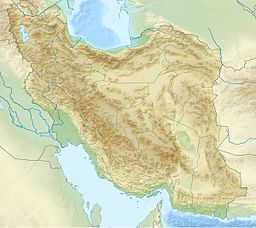Sardasht
| Sardasht (سردشت) | |
| (kurdiska) Serdeşt | |
| Stad | |
| Land | |
|---|---|
| Provins | Västazarbaijan |
| Koordinater | 36°09′19″N 45°28′47″Ö / 36.15528°N 45.47972°Ö |
| Folkmängd | 46 412 (24 september 2016)[1] |
| Geonames | 117111 |
Sardashts läge på karta över Iran. | |
Sardasht (persiska: سردشت) är en stad i provinsen Västazarbaijan i nordvästra Iran. Folkmängden uppgår till cirka 50 000 invånare och staden är belägen sydväst om Urmiasjön på cirka 1 300 meters höjd över havet. Befolkningen är främst sunnimuslimska kurder och azerisk-turkiska folkslag.
Sardasht ligger nära gränsen mellan Iran och den autonoma kurdiska delen av Irak. Sardasht är den första staden i världen som bombades med kemiska vapen[källa behövs], av Saddam Hussein den 28 juni 1987, under Iran-Irak kriget.
Namn
Vissa menar att namnet Sardasht kommer från "zartosh" som senare under arabisering ändrades till Sardasht. En annan förklaring är att staden ligger på ett fält nära sjön زاب[2]
Källor
- ^ www.amar.org.ir; Resultat från folkräkningen i Iran 2016 Läst 1 januari 2018.
- ^ معرفی سردشت. http://bukanmukri.org/site-articlepage/sardasht/2-sardasht-fa.html. Läst 4 februari 2015 Arkiverad 29 november 2014 hämtat från the Wayback Machine.
Media som används på denna webbplats
Flag of Iran. The tricolor flag was introduced in 1906, but after the Islamic Revolution of 1979 the Arabic words 'Allahu akbar' ('God is great'), written in the Kufic script of the Qur'an and repeated 22 times, were added to the red and green strips where they border the white central strip and in the middle is the emblem of Iran (which is a stylized Persian alphabet of the Arabic word Allah ("God")).
The official ISIRI standard (translation at FotW) gives two slightly different methods of construction for the flag: a compass-and-straightedge construction used for File:Flag of Iran (official).svg, and a "simplified" construction sheet with rational numbers used for this file.
Shiny red button/marker widget. Used to mark the location of something such as a tourist attraction.
Författare/Upphovsman: Uwe Dedering, Licens: CC BY-SA 3.0
Topographic map of the Iranian plateau in Central Asia, connecting to Anatolia in the west and Hindu Kush and Himalaya in the east.



